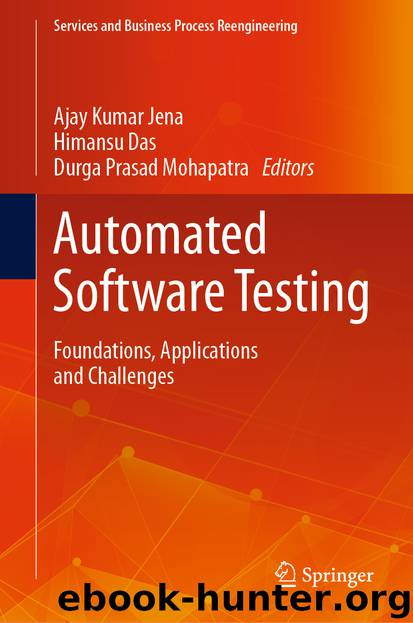Automated Software Testing by Ajay Kumar Jena & Himansu Das & Durga Prasad Mohapatra

Author:Ajay Kumar Jena & Himansu Das & Durga Prasad Mohapatra
Language: eng
Format: epub
ISBN: 9789811524554
Publisher: Springer Singapore
2 Related Work
During the last decade, researchers proposed many approaches to predict the reliability of component-based system software. These methods tried to predict the fault and using other software metrics for predicting reliability. Krishna and Mall [6] trained neural set to predict the reliability from structural and behavioral metrics of Unified Modeling Language (UML). Tripathi and Mall [7] proposed a model for early reliability prediction based on reliability block diagram, according to them coupling is the parameter which affects the reliability of the system. Dougan and Curran [8], Khave done the quantitative reliability prediction using Generalized Stochastic Petri Nets, based on rational unified process. Singh and Kumar [9] applied feed forward neural network of different data set to discuss the issues of network architecture. Sehgal and Mehrotra [10] predict the faults before testing phase using the Halstead metric to predict the reliability. Rathore and Kumar apply the genetic algorithm on data set to predict the faults from software system. Error rate evaluates the performance of this prediction model approach and recall. Validation of this fault prediction model is done by taking ten different projects from promise repository [11]. Malhotra et al. [12] designed a support vector machine model that determines the relationship at various severity levels. Faults can occur due to object-oriented design of software. Mohanta et al. proposed a bottom-up approach for object-oriented software that predicts the reliability of metrics gathered during the architectural stage. They have taken an object-oriented system and applied Bayesian Belief Network to predict the reliability [13]. Mohamed and Zulkernine [14] discussed the impact of failure propagation in component-based system; they have proposed a new technique to achieve the reliable design in an early phase of software development life cycle. Shatnawi and Li [15] found that software metrics are efficient to find out the classes prone to error.
There are various metrics like CBO, RFC, WMC, DIT, and NOC metrics which were used as forecasters to check the proneness of class errors. They have taken error log generated by Bugzilla and applied the all the object-oriented software metrics CBO, RFC, WMC, DIT, and NOC to predict faulty classes. Gyimothy et al. have taken CK metrics like WMC, DIT, RFC, and CBO to predict the faults from object-oriented system [16]. Xu et al. predict the faults in software modules using fuzzy nonlinear regression (FNR) system modeling design. Two neural network models are used to build FNR; one neural network is produced to reach upper limits of the dependent variable, and the other is to gauge lower limits [17]. Grunske presents a general framework to predict the quality of component-based system in early phases of software development life cycle [18]. Shin and Williams perform the statistical analysis on different complexity metrics to find out the impact of software complexity on security [19]. Jay presents the high correlation between lines of code and cyclomatic complexity [20]. Marcus et al. propose a new measure of classes that are cohesive depending on the unstructured data found in the source code like comments, and this newly purposed measure of cohesion can obtain out the more faulty classes [21].
Download
This site does not store any files on its server. We only index and link to content provided by other sites. Please contact the content providers to delete copyright contents if any and email us, we'll remove relevant links or contents immediately.
Algorithms of the Intelligent Web by Haralambos Marmanis;Dmitry Babenko(8517)
Building Statistical Models in Python by Huy Hoang Nguyen & Paul N Adams & Stuart J Miller(7289)
Azure Data and AI Architect Handbook by Olivier Mertens & Breght Van Baelen(7287)
Serverless Machine Learning with Amazon Redshift ML by Debu Panda & Phil Bates & Bhanu Pittampally & Sumeet Joshi(7176)
Data Wrangling on AWS by Navnit Shukla | Sankar M | Sam Palani(6937)
Driving Data Quality with Data Contracts by Andrew Jones(6920)
Machine Learning Model Serving Patterns and Best Practices by Md Johirul Islam(6663)
Learning SQL by Alan Beaulieu(6152)
Weapons of Math Destruction by Cathy O'Neil(6074)
Big Data Analysis with Python by Ivan Marin(5686)
Data Engineering with dbt by Roberto Zagni(4677)
Solidity Programming Essentials by Ritesh Modi(4339)
Time Series Analysis with Python Cookbook by Tarek A. Atwan(4178)
Pandas Cookbook by Theodore Petrou(3903)
Blockchain Basics by Daniel Drescher(3418)
Hands-On Machine Learning for Algorithmic Trading by Stefan Jansen(2953)
Natural Language Processing with Java Cookbook by Richard M. Reese(2907)
Feature Store for Machine Learning by Jayanth Kumar M J(2857)
Learn T-SQL Querying by Pam Lahoud & Pedro Lopes(2842)
